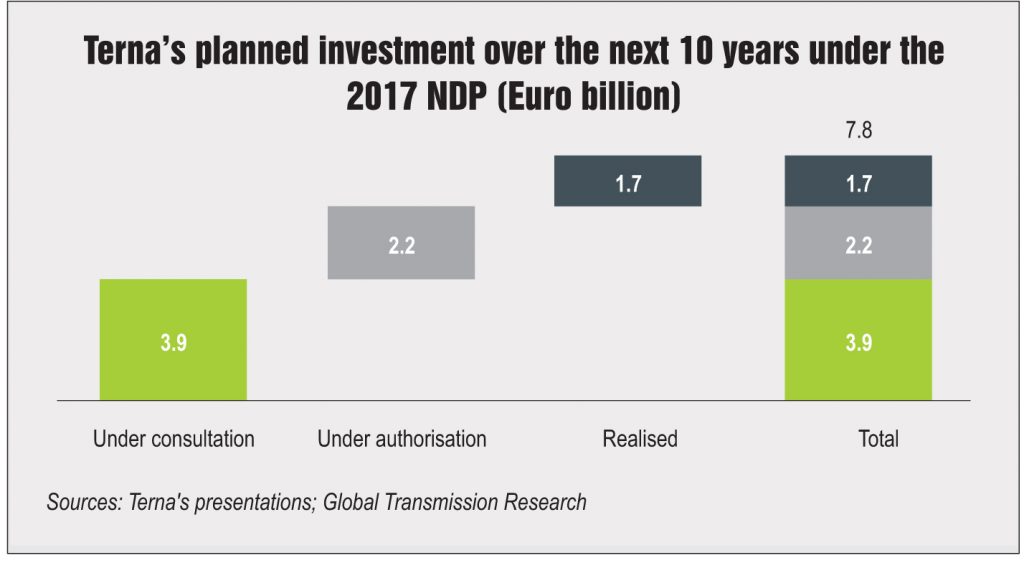
The structure of the electricity sector in Europe is undergoing a steady transformation driven by the huge growth in renewable energy resources and the decommissioning of conventional generation plants. This, in turn, is bringing about a sea change in the way future electricity grids are planned and developed. Transmission system operators are now pursuing projects that will facilitate the decarbonisation of the energy mix, achieve more efficient electricity markets and improve the security of electricity supply.
Italy’s high voltage grid developer and operator Terna has, for instance, designed its investment plans with special attention to environmental and sustainability issues. Over the next five years (2017-21), Terna foresees a capital expenditure of about Euro 4 billion for the country’s grid. This plan is aligned with the energy objectives of the European Union (EU), which are to be achieved through the strengthening of cross-border interconnections, solving local congestion issues and increasing the commitment towards the integration of renewables into the grid.
Of the Euro 4 billion capex for 2017-21, Terna is planning to allocate Euro 2.5 billion for projects covered in the National Development Plan (NDP) 2017. These projects fall under the categories of renewables integration, quality of service, cross-border interconnections, congestion management and connections to the national grid. Further, the company is looking to spend Euro 800 million on replacement projects and Euro 400 million on defence projects (projects for the protection and control of the system, asset monitoring, frequency control, etc.). The remaining Euro 300 million has been kept for other strategic projects.
In addition, under the NDP 2017, the company is expected to invest Euro 5.3 billion in the projects that will be implemented after 2021. Thus, the NDP 2017 foresees a total investment of around Euro 7.8 billion over the next 10 years.
Terna’s various developmental projects can be further classified as:
- Projects aimed at increasing the cross-border interconnection capacity, reducing procurement costs and increasing electricity trade.
- Projects aimed at reducing congestion between market areas in Italy, leading to greater competition in the electricity market and increase in the utilisation of existing capacity including that from renewable sources.
- Projects aimed at reducing the intra-zonal congestion and capacity constraints, which will allow full exploitation of efficient generation resources.
- Projects aimed at improving the safety and reliability of the network in metropolitan areas.
- Projects aimed at improving the quality, continuity as well as security of electricity supply.
Based on the above categorisation, Terna is pursuing the following key projects:
Cross-border interconnections
- Grand’Ille (France)-Piossasco (Italy) underground high voltage direct current (HVDC) interconnector: The project aims to increase electricity transport capacity across Italy’s northern border with France. It is a 190 km, ±320 kV underground cable link with converter stations at both ends (two poles, each with a maximum capacity of 600 MW). A consortium of seven companies led by Italy’s Prysmian Group will construct the underground link. The project is scheduled for completion in 2019.
- Villanova (Italy)-Lastva (Montenegro) undersea HVDC interconnector: It is a 455 km long, ±500 kV HVDC undersea interconnection between Italy and Montenegro. It will have a capacity of 1,000 MW and converter stations at both end points. Nexans has the contract to construct the link, which is targeted for completion in 2019.
Besides these two projects, Terna is studying new electricity interconnection projects with Switzerland, Slovenia and Tunisia, as well as enhancing the capacity of the Italy-Austria interconnector.
Reducing congestion
The key projects being implemented to address bottlenecks between market areas include:
- The 380 kV Colunga-Calenzano line to increase the trading limits on the north-north centre section
- The 380 kV Foggia-Villanova and Deliceto-Bisaccia lines to increase exchange in south-south centre and facilitate the evacuation of renewable energy generation in the south
- The 380 kV Montecorvino-Avellino-Benevento line to increase the trading limits on the south-south centre section
- Reorganisation of the North Calabria network, which will help evacuate production from renewable sources in Calabria.
In 2016, in order to reduce congestion, Terna completed a major project, the 380 kV Sorgente-Rizziconi line (including a 38 km undersea cable), linking Sicily to the rest of Italy. This removed a major bottleneck in Italy and eliminated the price differential between Sicily and the rest of the country, leading to savings of Euro 600 million.
Reducing intra-zonal congestion and capacity constraints
The key projects include:
- A 380 kV line between Milan and Brescia to reduce congestion in the corridor between the northwest and northeast of the country
- The 380 kV Udine-Redipuglia line to reduce constraints on the network section along the Redipuglia node that limit trade with Slovenia
- Upgrading the Middle Piave Valley network to reduce congestion and encourage production from renewable sources
- The 380 kV Paternò-Pantano-Priolo and Chiaramonte Gulfi-Ciminna lines for exchange with Sicily.
Terna also plans to begin work on a new project, SACO I3, which will connect Sardinia, Corsica and mainland Italy.
Quality and security of supply
Terna has also planned other projects to ensure the quality and security of supply. Examples are the 40 km, 132 kV Elba-mainland Italy subsea cable, and a 150 kV interconnection between the islands in Campania and mainland Italy.
Conclusion
Terna is thus pursuing various investment projects not only to contribute towards the EU’s energy objectives but also to strengthen its internal grid to ensure reliable and secure supply of electricity. However, the company is facing huge challenges given that a large number of projects are still to be approved by local authorities




